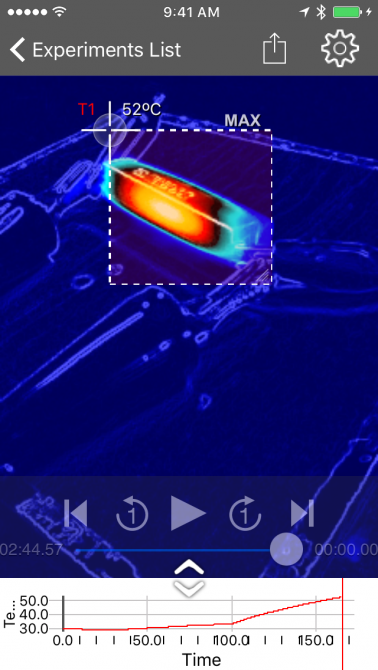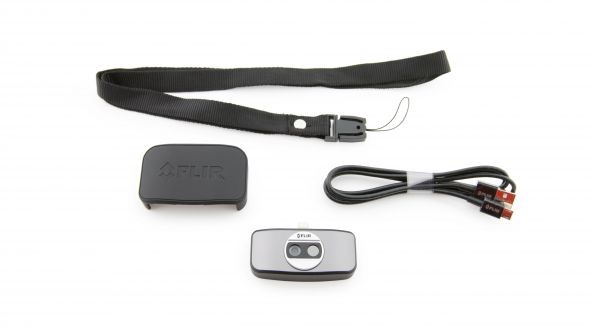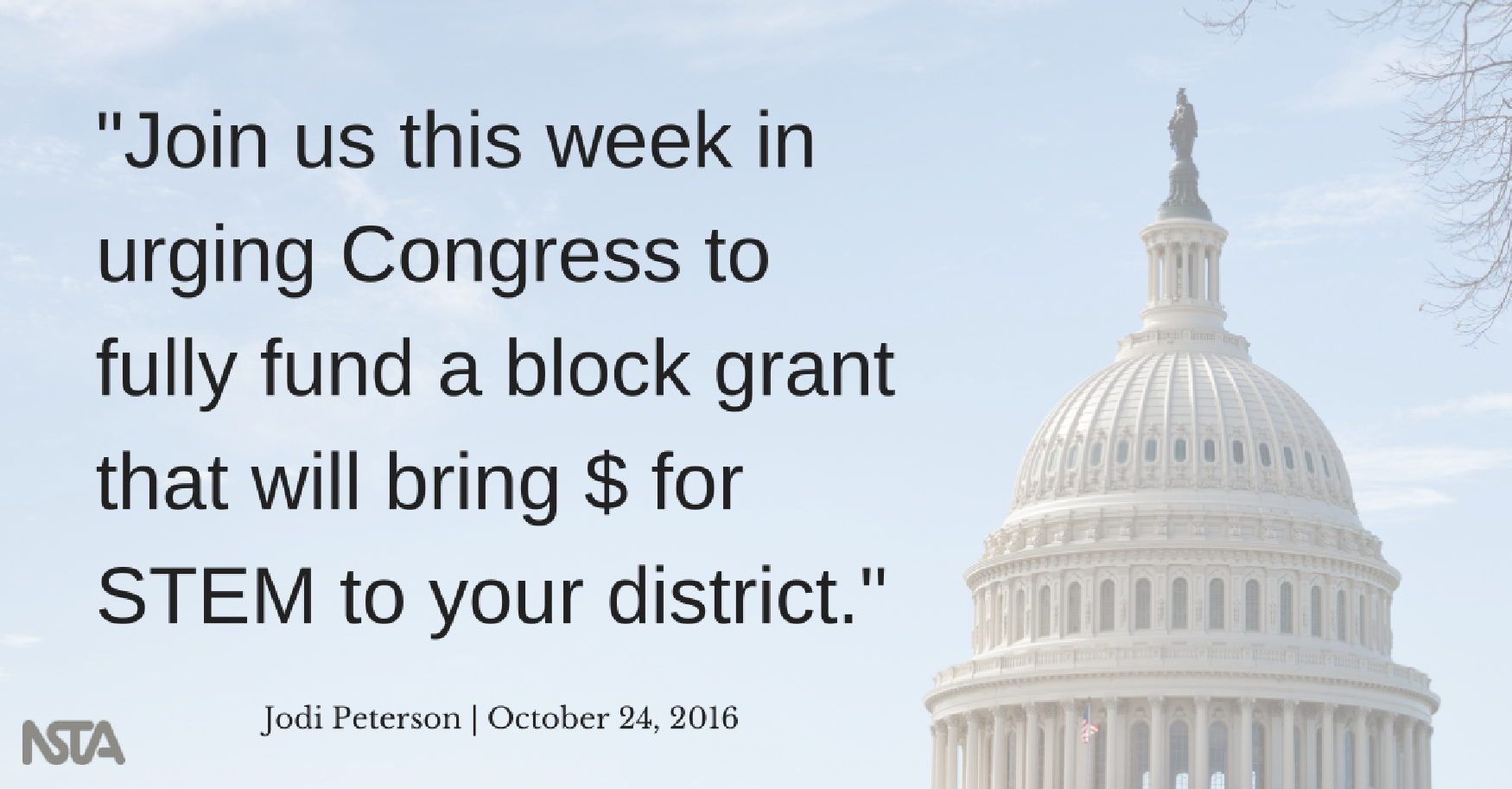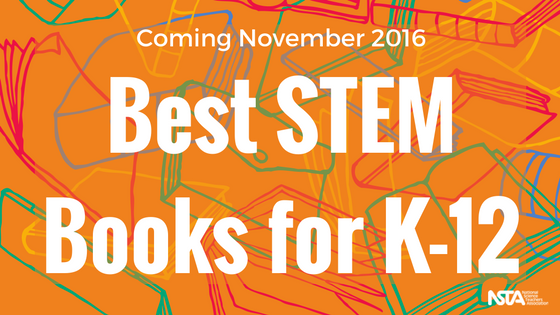Just as its subtitle says, this important book aims to reshape your approach to teaching and your students’ way of learning.
Just as its subtitle says, this important book aims to reshape your approach to teaching and your students’ way of learning.
Time for science?
By Mary Bigelow
Posted on 2016-10-30
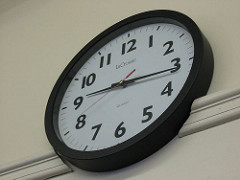 When I was student teaching, I had some really good science lessons for second-graders that lasted about an hour. But now I have only a half-hour for science each day. I need suggestions for shorter lessons. – C., Colorado
When I was student teaching, I had some really good science lessons for second-graders that lasted about an hour. But now I have only a half-hour for science each day. I need suggestions for shorter lessons. – C., Colorado
I’m glad to hear that your school schedules science daily. In many elementary schools, science and social studies have been deemphasized, in favor of reading and math.
- If your schedule is flexible enough, “borrow” time from another subject to complete the activity, making up the time later.
- Divide the activity into several parts, perhaps making observations or collecting data one day and doing the analysis or summarization later. (You may have to include time to review on the second day)
- Use time during writing instruction for students to summarize the lesson in their science notebooks.
- Use nonfiction books on the topic during reading instruction, read-alouds, or personal reading to provide background prior to or after the science lesson.
Each month, NSTA’s Science & Children publishes features to help educators craft additional age-appropriate lessons:
- Teaching with Trade Books explores a concept with recommended books and lessons. For example, the September 2016 topic is “What We Do With Ideas.”
- The Early Years features easy-to-use ideas for developing student interest and curiosity. The July 2016 topic is “Discovering Through Deconstruction.”
- Articles related to the monthly theme include lesson plans, connections to the Next Generation Science Standards, and related materials.
Even at the secondary level, the class period is often not long enough to complete an investigation or activity. And I’ve never heard science teachers say they had too much time!
Photo: https://www.flickr.com/photos/cgc/7080721/sizes/q/
Tackling Scientific Problems and Pitching Engineering Solutions at #NSTA16 Columbus
By Lauren Jonas, NSTA Assistant Executive Director
Posted on 2016-10-29

This December, the National Science Teachers Association (NSTA) will feature a special strand “Tackling Scientific Problems and Pitching Engineering Solutions” at our 2016 Area Conference on Science Education, in Columbus, Ohio, December 3-5. We need this strand, because the challenges facing society are both complex and interdisciplinary. Issues like water availability/quality, climate change, renewable energies, food shortages, the need for improved transportation/city infrastructure, and issues in the biomedical realm require clearly defining problems that can be solved through design. Students address these issues by implementing the practices of scientists and engineers, including developing explanations, designing and building models, and creating solutions. Students must be able to link the domains of science and teachers must teach students in a learnable manner that reaches multiple grade levels, increasing in depth and sophistication.
 The featured presentation for this strand will be “Sowing the Seeds of STEM,” on Friday, December 2, from 12:30 PM – 1:30 PM at the Greater Columbus Convention Center, B130. Presenter Kimberly Clavin (Pillar Technology: Columbus, OH) tells us that today’s world delivers advanced technologies at lightning speeds—and with that comes an exponential growth in STEM fields. How can educators prepare middle school and high school students without a background in the emerging fields? Learn various strategies to attract and grow a diverse range of students into these in-demand career fields.
The featured presentation for this strand will be “Sowing the Seeds of STEM,” on Friday, December 2, from 12:30 PM – 1:30 PM at the Greater Columbus Convention Center, B130. Presenter Kimberly Clavin (Pillar Technology: Columbus, OH) tells us that today’s world delivers advanced technologies at lightning speeds—and with that comes an exponential growth in STEM fields. How can educators prepare middle school and high school students without a background in the emerging fields? Learn various strategies to attract and grow a diverse range of students into these in-demand career fields.
Below is a small sampling of other sessions on this topic:
- Human-Centered Engineering Design: The Key to STEM
- Developing Scientific Arguments: Claims and Stories in the Graphs
- Learning Ecosystem Management with NGSS: Developing Solutions to Invasive Species Using Science and Engineering Practices
- EiE Ohio: Building 21st-Century STEAM Learners
- Impactful Learning: Engineering to Serve Special Needs Students—The Win-Win Scenario
- Teaching Engineering in Grades K–3
 Want more? Browse the program preview, or check out more sessions and other events with the Columbus Session Browser/Personal Scheduler. Follow all our conference tweets using #NSTA16, and if you tweet, please feel free to tag us @NSTA so we see it!
Want more? Browse the program preview, or check out more sessions and other events with the Columbus Session Browser/Personal Scheduler. Follow all our conference tweets using #NSTA16, and if you tweet, please feel free to tag us @NSTA so we see it!
The mission of NSTA is to promote excellence and innovation in science teaching and learning for all.
Future NSTA Conferences
2017 National Conference
2017 STEM Forum & Expo
Follow NSTA

Only at NSTA Minneapolis: #ToysForNerds
By Lauren Jonas, NSTA Assistant Executive Director
Posted on 2016-10-29
Uh oh, someone hold me back #toysfornerds #ONLYatNSTA pic.twitter.com/AdKmAvsfjE
— Sara Kobilka (@SaraKDM) October 28, 2016
"A zombie got my leg" #STEM challenge to create a prosthetic leg #nsta2016 #nsta16 @TeachNgineering pic.twitter.com/EP5JGQzr5r
— Matt Nupen (@mattnupen) October 29, 2016
#ONLYatNSTA I DO love being a science teacher! pic.twitter.com/YQf6Bp74eT
— Stephanie Francis (@tagteacher2002) October 27, 2016
#scienceteachers change the world one “Why?” at a time! @ainissaramirez tells us how #OnlyAtNSTA pic.twitter.com/jQteaj5OVz
— Lauren Jonas (@LaurenE_Jonas) October 27, 2016
@SPPS_Science @SPPS_News Jim Schrankler being recognized as a Presidential Award Finalist at MNSTA #OnlyAtNSTA pic.twitter.com/TKhnu8PTpY
— Sarah Bosch (@sbosch_spps) October 27, 2016
#ONLYatNSTA pic.twitter.com/HgTSQXp8w3
— NatSciTeachAssoc (@NSTA) October 29, 2016
SMHS in da house!#onlyatnsta#sciencerocks pic.twitter.com/yojxhIgA0z
— Dawn Paurus (@dawn_paurus) October 28, 2016
#nsta16 what’s more fun than teaching science??!! Learning to teach science with all your fav science teachers! #knightnation pic.twitter.com/bPNRL9FYrn
— Ms. Volkmann (@ScienceMsV) October 28, 2016
That time you happened on forensic clues on your way to an #NSTA16 session. #OnlyAtNSTA pic.twitter.com/0CWZLE66Xr
— Claire Reinburg (@C_Reinburg) October 27, 2016
Prism glasses and a light show. #onlyatnsta @KatieAEnglund @Shellygilson1 pic.twitter.com/SpXmdDAywm
— Courtney Qualley (@QualleyCourtney) October 28, 2016
#OnlyAtNSTA Can I play with clay and learn science! pic.twitter.com/3LOozv9fmL
— Barbara Wendt (@WendtScience) October 28, 2016
#onlyatnsta Prof. Tubesing lights up ASEE engineering day!! pic.twitter.com/gxGwtBgUao
— Deb Besser (@Deb_Besser) October 28, 2016
Day 2 of the science teachers conference in Minneapolis #NSTA #OnlyAtNSTA #NSTA16 pic.twitter.com/4v8SdxvoVo
— Beth Hamilton (@deafsciencebeth) October 28, 2016
Kazoo engineering expert #carolinaredcarpet #OnlyAtNSTA pic.twitter.com/F1gqWvtXMM
— Sara Kobilka (@SaraKDM) October 28, 2016
New & old STEM Forum members collaborate as we plan out 2017 STEM Forum. Good times and plans #NSTA16 #OnlyAtNSTA pic.twitter.com/nU2NdyAdfO
— Jennifer Williams (@ScienceJennifer) October 27, 2016
Red kneed tarantula #ONLYatNSTA pic.twitter.com/sK829MXmYC
— tim ronhovde (@mctreehugger) October 28, 2016
Welcome to Twitter! #OnlyAtNSTA https://t.co/0okZgDSnLD
— Sarah Bosch (@sbosch_spps) October 28, 2016
#OnlyAtNSTA @ZWSTEAMRoller @mikesavage1 pic.twitter.com/GIcXRW2OeQ
— Sara Welu (@Sdub1078) October 28, 2016
Reverse engineering a kazoo. Let’s get destructive!! How can I break this? The dark side is so tempting and encouraged! #OnlyAtNSTA pic.twitter.com/GAoxEDvxnF
— Sara Kobilka (@SaraKDM) October 28, 2016
In a highly unscientific survey it has been decided that the cutest dog in the world is #ONLYatNSTA pic.twitter.com/mXak7gZGJm
— NatSciTeachAssoc (@NSTA) October 6, 2016
Reverse engineering a kazoo. Let’s get destructive!! How can I break this? The dark side is so tempting and encouraged! #OnlyAtNSTA pic.twitter.com/GAoxEDvxnF
— Sara Kobilka (@SaraKDM) October 28, 2016
Won $50 at the door prize at the first session ! #onlyatNSTA Thanks #vernier ! #STEM #scied #NSTA pic.twitter.com/VmanbeSNIv
— Kim Nesvik (@knesvik1) October 28, 2016
Learning to use google forms for assessment from @kamelgaard at #NSTA16 #NSTA2016 #OnlyAtNSTA pic.twitter.com/cipuYLZGkw
— Matt Nupen (@mattnupen) October 28, 2016
MVPS Science teachers at NSTA in Mlps. Great day of professional learning. #mvteachers #mvpsrocks pic.twitter.com/BCoRRNabD5
— MV Curriculum (@MV_CIA) October 27, 2016
I want this!!! Saw this atomic model at the exhibit @FreyScientific #NSTA16 #NSTA #OnlyAtNSTA pic.twitter.com/BcArsvYY2Q
— Beth Hamilton (@deafsciencebeth) October 28, 2016
Happy to be with family in Minneapolis. #onlyatNSTA #NSTA16 @NSTA# @bflyguy @JeanTushie pic.twitter.com/vkknC0rAxE
— Christine Anne Royce (@caroyce) October 27, 2016
Designing on a seriously deficit budget #onlyatnsta pic.twitter.com/u0b7uRk4Ox
— Rhonda Fode (@CoachFode) October 27, 2016
…and then I won $75 to use on my class!!!#OnlyatNSTA pic.twitter.com/MnYn837y7M
— Courtney Qualley (@QualleyCourtney) October 27, 2016
Conference exp part 1: why yes TSA they are children’s books & 150 paper helicopters. I’m a science teacher #onlyatNSTA @nsta #NSTA16
— Christine Anne Royce (@caroyce) October 26, 2016
We are looking good #ONLYatNSTA pic.twitter.com/wAQK5rwomx
— Jodi Peterson (@stemedadvocate) October 28, 2016
Won a Starbucks gift card for creating the loudest kazoo! Me, loud, who’d have thunk it?!? #engineeringwinner #STEAM #OnlyAtNSTA pic.twitter.com/CEjgrxNsHz
— Sara Kobilka (@SaraKDM) October 28, 2016
Hanging out with Joe Mauer at NSTA. #ONLYatNSTA #NSTA2016 pic.twitter.com/JrnKpINiZn
— Scot Johnson (@scotjohn30) October 28, 2016
Great PD!!! #OnlyAtNSTA pic.twitter.com/Pi3mP77BiT
— Jacey Brown (@brown_ja3) October 28, 2016
#OnlyAtNSTA Can I read a science paper from 1953 on DNA, and build what they discovered with pool noodles, magnets, and 3D printers-😁 pic.twitter.com/HpJjO4vvKc
— Barbara Wendt (@WendtScience) October 28, 2016
Thank you Victor Sampson for leading a great un-conference discussions on argument-driven inquiry. #ONLYatNSTA @nsta pic.twitter.com/JZVWYbeIXS
— Kim Stilwell (@KimStilwellNSTA) October 28, 2016
Met my #sciencesuperhero and got some smart advice today. THANK YOU @ainissaramirez pic.twitter.com/mDBgIliNZu
— Lauren Jonas (@LaurenE_Jonas) October 28, 2016
Hands on digestion #onlyatnsta pic.twitter.com/8w9F0O8Dyr
— Rhonda Fode (@CoachFode) October 27, 2016
Gotta love a hands-on engineering session where cheers erupt throughout the design process. #ONLYatNSTA pic.twitter.com/5cjEoFAuPR
— Sara Kobilka (@SaraKDM) October 28, 2016
When the presenter happens to use a book you wrote in her session. #surprise! #OnlyatNSTA #NSTA16 #NGSS #ece #STEMed @charlesbridge pic.twitter.com/XITOA4gPAt
— Ruth Spiro (@RuthSpiro) October 28, 2016
A great start to the NSTA area conference #ONLYatNSTA And a big thank you to NSTA and MN’s local planning team pic.twitter.com/bZvjwnRGQt
— Steve Walvig (@SteveWalvig) October 27, 2016
The mission of NSTA is to promote excellence and innovation in science teaching and learning for all.
2016 Area Conferences
2017 National Conference
2017 STEM Forum & Expo
Follow NSTA
Bring More Everyday Engineering into your classroom
By Carole Hayward
Posted on 2016-10-28
A new book by NSTA Press helps middle school teachers incorporate engineering into their science classrooms.
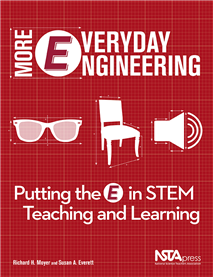 More Everyday Engineering: Putting the E in STEM Teaching and Learning is a follow-up volume to 2012’s Everyday Engineering. The book is based on the “Everyday Engineering” column in NSTA’s middle school journal Science Scope and captures how engineering is required to make items from ice cubes to bandages. Authors Richard H. Moyer and Susan A. Everett do an excellent job at providing lessons that illustrate how “engineering is the process we use to develop solutions to the problems humans face.”
More Everyday Engineering: Putting the E in STEM Teaching and Learning is a follow-up volume to 2012’s Everyday Engineering. The book is based on the “Everyday Engineering” column in NSTA’s middle school journal Science Scope and captures how engineering is required to make items from ice cubes to bandages. Authors Richard H. Moyer and Susan A. Everett do an excellent job at providing lessons that illustrate how “engineering is the process we use to develop solutions to the problems humans face.”
The activities are designed to give students an in-depth understanding of three different aspects of engineering—designing and building; reverse engineering to learn how something works; and constructing and testing models. Moyer and Everett use the 5E learning-cycle format in each activity and focus on items that students are familiar with such as sunglasses and speakers and earbuds.
Chapter 4, “An In-depth Look at 3-D,” is particularly relevant to middle school students who have grown up surrounded by the latest 3-D technology in video games, televisions, and movies. The activity worksheet in that chapter focuses on vision and perception as a means to investigating 3-D. Each of the chapters in the book provide helpful teacher background information, historical context, a materials list, and safety information.
The Next Generation Science Standards (NGSS) stress the importance of incorporating engineering and technology into the science classroom. This book can help teachers connect science and engineering, and can serve as a useful tool for engineers leading outreach activities, leaders of after-school and summer enrichment programs, and parents. Most importantly, the book helps provide opportunities for students “to deepen their understanding of science by applying their developing scientific knowledge to the solution of practical problems” (see NGSS, Appendix A).
This book is also available as an e-book.
Fall for These Savings on NSTA Press Books!
Between now and November 1, 2016, save $15 off your order of $75 or more of NSTA Press books or e-books by entering promo code BKS16 at checkout in the online Science Store. Offer valid only on orders placed of NSTA Press books or e-books on the web and may not be combined with any other offer.
Follow NSTA
A new book by NSTA Press helps middle school teachers incorporate engineering into their science classrooms.
FLIR ONE Thermal Imaging Camera
By Edwin P. Christmann
Posted on 2016-10-27
Introduction
The imaginations of middle school and high school students will be fully engaged in the science classroom with the FLIR ONE Thermal Imaging Camera. This camera’s thermal capabilities allow students to explore things invisible to the human eye. For example, students can use the camera to investigate the world of thermodynamics in a manner that parallels the excitement and mystery evoked by sitting on the edge of your seat during a cutting-edge science fiction movie.
How does it work?
What we can see with naked eye is restricted to visible light. Therefore, when you consider the electromagnetic spectrum (EM), which encompasses radio waves, microwaves, infrared light, visible light, ultraviolet light, x-rays, and gamma rays, it becomes evident that what we can see with our eyes is limited. As an example, devices such as military night vision goggles make it possible to see images in the dark. In a similar way, the FLIR ONE Thermal Imaging Camera is a device for us to “see” beyond visible light.
Thermal-imaging cameras, like the FLIR ONE, can “see” heat signatures, which are converted to display variations of temperatures, e.g., How an icy soft drink contrasts with the flame on a candle. This is because all objects emit thermal energy and the hotter the object; the more energy given off by the object. The energy emitted is known as the “heat signature.” Hence, every object has a different heat signature; and it’s those signatures that are detected by thermal imagers like the FLIR ONE. Moreover, since thermal cameras are not concerned with visible light, regardless of lighting conditions, thermal cameras can detect the different heat signatures in a variety of situations. Therefore, images of temperature variations can be observed with this type of device.
FLIR ONE Thermal Imaging Camera Compatibility
The Thermal Camera is made for the iPhone and the iPad. It is very easy to use and, because no interface is needed, it is a snap to use in the classroom. Subsequently, teachers will have no problem having students connect the device for experiments. The first step, however, is load the free Vernier Thermal Analysis for FLIR ONE application, which is available for download on the iTunes App Store [https://itunes.apple.com/us/app/vernier-thermal-analysis-for/id1083139486?mt=8]. It requires iOS 9.0 or better and should be installed before connecting the camera to your device. The Vernier Thermal Analysis for FLIR ONE application is simple to access and takes only a few minutes to upload.
As explained in the iTunes store:
“Vernier Thermal Analysis for FLIR ONE allows you to mark up to four locations or regions on a thermal image. In a selected region, you can determine minimum, maximum, or average temperature. Graph temperature data live during an experiment, then export to our Graphical Analysis app for further analysis. Thermal image videos can also be exported to the Photos app.”
The Thermal Camera, in conjunction with the Thermal Analysis app, can do much more than simply detect heat. Students will also be able to record and graph live temperature data from up to four locations on an image. This will allow them to compare the temperature data between different locations during an experiment. Furthermore, each picture taken with this device will also simultaneously take a standard picture, providing greater detail of the image.
The FLIR ONE can be used across the science content areas (i.e., physics, chemistry, earth science, biology, etc.) and will definitely enhance the study of thermodynamics for students– especially for visual learners! Below are samples of links to ideas for classroom experiments:
Rubbing erasers, hands and ice: http://80.77.70.144/DocDownload/Assets/edu/T810113-en-US.pdf
Knife and wooden spoon: http://80.77.70.144/DocDownload/Assets/edu/T810111-en-US.pdf
Cups and clothes: http://80.77.70.144/DocDownload/Assets/edu/T810109-en-US.pdf
Conclusion
The FLIR ONE Thermal Camera is a new technology application that engages students into meaningful and exciting inquiry-based learning! Undoubtedly, this user-friendly device has a kaleidoscope of meaningful uses for 21st Century science classrooms! There is little doubt that its use will spawn creativity and heighten the interest of thermodynamics content for students!
Equipment and Cost:
Cost: $249
http://www.flir.com/flirone/ios/
http://www.vernier.com/products/sensors/temperature-sensors/flirone-ios/
Edwin P. Christmann is a professor and chairman of the secondary education department and graduate coordinator of the mathematics and science teaching program at Slippery Rock University in Slippery Rock, Pennsylvania. Anthony Balos is a graduate student and a research assistant in the secondary education program at Slippery Rock University in Slippery Rock, Pennsylvania.
Introduction
The imaginations of middle school and high school students will be fully engaged in the science classroom with the FLIR ONE Thermal Imaging Camera. This camera’s thermal capabilities allow students to explore things invisible to the human eye. For example, students can use the camera to investigate the world of thermodynamics in a manner that parallels the excitement and mystery evoked by sitting on the edge of your seat during a cutting-edge science fiction movie.
Working cooperatively
By Mary Bigelow
Posted on 2016-10-26
 I’m frustrated by my sixth graders. When they’re supposed to be working cooperatively, they are unfocused—it seems more like a social event. By middle school, shouldn’t students know how to work cooperatively? Or are they too immature? – G., Virgina
I’m frustrated by my sixth graders. When they’re supposed to be working cooperatively, they are unfocused—it seems more like a social event. By middle school, shouldn’t students know how to work cooperatively? Or are they too immature? – G., Virgina
Immaturity is not an excuse. I’ve seen wonderful cooperative learning taking place in kindergarten classes, with teacher guidance, modeling, and monitoring.
One might assume students have specific skill sets and experiences, but I’ve learned never to take anything for granted. If the students attended different elementary schools, their science backgrounds and the emphasis schools placed on science investigations will vary. You may have to teach (or remind) students what cooperative learning in science looks like.
Defining roles is a key component. Common roles in middle level science labs include group leader, presenter, data recorder, measurer, equipment manager, liaison/questioner, artist/illustrator, online researcher, timekeeper, and notetaker. Depending on the size of the groups, some roles can be combined.
It may help to have students define the roles, giving them ownership in the process. Ask, “What would a data recorder do?” (Students must answer without using the words data or recorder.) You can add suggestions, especially on safety. Job descriptions could be shared as posters, student-created videos, or put into students’ notebooks. Rotate roles periodically so all students have a chance to experience each one.
If some students lack polished interpersonal skills, start with brief, structured activities. Model cooperative behaviors and share examples of appropriate (and inappropriate) language.
To keep the groups focused and on-task, be sure students understand the purpose and the learning goals for the project or investigation and monitor them as they work.
Middle schoolers are capable of working cooperatively, and their enthusiasm is a bonus!
Photo: https://www.flickr.com/photos/xevivarela/4610711363/sizes/o/in/photostream/
 I’m frustrated by my sixth graders. When they’re supposed to be working cooperatively, they are unfocused—it seems more like a social event. By middle school, shouldn’t students know how to work cooperatively? Or are they too immature? – G., Virgina
I’m frustrated by my sixth graders. When they’re supposed to be working cooperatively, they are unfocused—it seems more like a social event. By middle school, shouldn’t students know how to work cooperatively? Or are they too immature? – G., Virgina
Immaturity is not an excuse. I’ve seen wonderful cooperative learning taking place in kindergarten classes, with teacher guidance, modeling, and monitoring.
Join the National Day of Action for Full Funding of ESSA Student Success
By Jodi Peterson
Posted on 2016-10-24
Science educators, teacher leaders, and others in the STEM education community are encouraged to join thousands of K-12 educators, counselors, technology specialists, and librarians on October 26 for the national “Day of Action” to urge Congress to fully fund the flexible block grant (Student Support and Academic Enrichment Title IV, Part A) recently authorized in the Every Student Succeeds Act (ESSA).
The Student Support and Academic Enrichment (SSAE) block grant is designed to ensure that high needs districts have access to programs that foster safe and healthy students, provide students with a well-rounded education, and increase the effective use of technology in our nation’s schools.
Districts can choose to spend their Title IV/A dollars to improve instruction and student engagement in STEM by:
- Expanding high-quality STEM courses;
- Increasing access to STEM for underserved and at risk student populations;
- Supporting the participation of students in STEM nonprofit competitions (such as robotics, science research, invention, mathematics, computer science, and technology competitions);
- Providing hands-on learning opportunities in STEM;
- Integrating other academic subjects, including the arts, into STEM subject programs;
- Creating or enhancing STEM specialty schools;
- Integrating classroom based and afterschool and informal STEM instruction; and
- Expanding environmental education.
Advocates are trying to drive the highest possible funding level for the program, and are asking their members to call on lawmakers to fully fund this program.
Send a pre-written letter to your Member of Congress via the STEM Education Coalition Congressional Action Center
Call or email the Member’s office and ask to speak to the legislative assistant who handles appropriations issues. Call the Capitol Hill switchboard at (202) 224-3121 and ask to be connected to your member of Congress. If the legislative assistant is not in, you can leave a voicemail with your request. A sample script can be found here.
Send a tweet to your members of Congress.
Read the press release on the Title IV/A National Day of Action here.
It is important we get as many teachers as possible to contact their member of Congress. This is the first year for this grant program so it is critical that Congress appropriates a robust level of funding. Questions? Email me at jpeterson@nsta.org.
ED Releases Guidance on Title IVA Programs
The U.S. Department of Education has released its guidance document on Title IV,A Student Support and Academic Enrichment Grant (mentioned above). The guidance provides key information on the provisions of the new SSAE program including a discussion of the allowable uses of funds, role of the SEA, fiscal responsibilities, and the local application requirements. Read more here.
Sign the STEM Education Coalition letter to State Stakeholders on ESSA Implementation
The STEM Education Coalition is circulating a letter among the STEM education community asking stakeholders and interested organizations to join onto a sign-on letter that calls for state and local policymakers to prioritize STEM as they put together plans to implement the Every Student Succeeds Act. View the letter here; if your organization would like to sign on, please contact Lindsey Gardner of the Coalition at lgardner@stemedcoalition.org with your organization’s name and contact info. The deadline to sign on is Friday, November 4.
Jodi Peterson is Assistant Executive Director of Legislative Affairs for the National Science Teachers Association (NSTA) and Chair of the STEM Education Coalition. e-mail Peterson at jpeterson@nsta.org; follow her on Twitter at @stemedadvocate.
Follow NSTA
Best STEM Books for K-12: List Coming Soon from NSTA
By Guest Blogger
Posted on 2016-10-22
Over the last few years, members of the teaching community have asked for a list of books containing the best STEM content for K–12. So we’re thrilled to be working on that now and to be able to invite readers to join us in late November, when we announce the list. Please bookmark this site (Best STEM Books for K–12), and follow NSTA on Twitter or Facebook to see if your favorite books make the list.
From METS to STEM
When an acronym becomes so common that users forget its origins, it can take on a life of its own. That’s what’s happened to STEM. The integration of mathematics, engineering, technology, and science began as a model (“METS”) in grant funding. From a basket category for college and career, STEM has now become a model for education from early childhood onward.
But the journey from a paradigm to implementation has proved challenging in school settings. In many schools “silos” still exist; Teachers of each discipline form a community of learning and cooperate in their ideas, but often the ways of knowing in each discipline remain.
STEM is more than a concept diagram with connections among four (or more) subject areas. It’s a unique way of knowing and exploring the world. The STEM approach involves the essence of the practices of science and engineering. Tools like mathematics, technology, and communication skills are interwoven in STEM explorations. That seamlessness is what challenges educators around the world.
Nowhere is that more obvious than when teachers look to find literature to integrate into a STEM curriculum. NSTA has worked with the Children’s Book Council for 45 years to identify Outstanding Science Trade Books. Often in their annotations the reviewers have indicated the winners were great for STEM curricula.
But are they really STEM? Experts, including the NSTA Board, were interested in the question. The first draft of a new set of criteria came from J. Carrie Launius at the University of Missouri. In her research, Launius proposed that redefining the STEM literature genre would not only improve teachers’ understanding of the approach but would raise the level of understanding among students.
To represent the philosophy of STEM, NSTA invited a unique collaboration with three other groups, the American Association of Engineering Educators, the International Technology and Engineering Educators Association, and the mathematics reps from Society of Elementary Presidential Awardees. Through almost a year of study, the group came up with these criteria for the best STEM literature for young readers:
STEM Superlatives
The best books would invite STEM‐like thinking by
- Modeling real‐world innovation
- Embracing real‐world design, invention and innovation
- Connecting with authentic experiences
- Showing assimilation of new ideas
- Illustrating teamwork, diverse skills, creativity, and cooperation
- Inviting divergent thinking and doing
- Integrating interdisciplinary and creative approaches
- Exploring multiple solutions to problems
- Addressing connections between STEM disciplines
- Exploring Engineering Habits of Mind
- Systems thinking
- Creativity
- Optimization
- Collaboration
STEM in Practice
The best STEM books might represent the practices of science and engineering by:
- Asking questions, solving problems, designing and redesigning
- Integrating STEM disciplines
- Showing the progressive changes that characterize invention and/or engineering by
- Demonstrating designing or redesigning, improving, building, or repairing a product or idea
- Showing the process of working through trial and error
- Progressively developing better engineering solutions
- Analyzing efforts and makes necessary modifications along the way
- Illustrates at points, failure might happen and that is acceptable providing reflection and learning occurs.
- Communication
- Ethical considerations
Challenging criteria, to be sure. What might be most startling is what they don’t include: specific requirements for extensive content in any of the individual subject areas. This was a subject of extensive discussion by the group. In the end, they decided that while a great integrated STEM book might have a lot of content, a book might represent the best STEM attitudes and practices an be just plain “inviting.”
Next, the Children’s Book Council took over, contacting dozens of publishers to let them know the effort was underway. And the results: Astounding! While in most years about 150 books are submitted for Outstanding Science Trade Books, the first solicitation for Best STEM Books drew more than double that many.
But of course, it was a new process and a new vision. Among the entries were many really great books about science, some new approaches to mathematics and some fascinating engineering stories. But were they STEM? Did they tell? Or invite?
Months of reading and rich discussions ensued. Books were read, rated and re-examined. Judges struggled to separate the content of the books from the ways that creative STEM teachers could use them.
What Will Make the List?
But in the end, the process worked. The collaboration among teachers from different backgrounds proved that STEM works—in all sorts of problem-solving situations.
The result is a list of BEST STEM books that the associations hope will help influence not just publishing but education at all levels. The field is blooming!
So the Associations and their representatives invite you to enjoy the first list of the best STEM literature—coming in November. We can’t wait to share!
2016 Selection Committee
Juliana Texley, NSTA Past President; Carrie Launius, NSTA District XI Director, Retired K-12 Classroom Teacher, St. Louis, MO; Christine Royce, Professor, Department of Teacher Education, Shippensburg University; Pamela S. Lottero-Perdue, Ph.D., Associate Professor of Science Education, Director, Integrated STEM Instructional Leadership (PreK-6) Post-Baccalaureate Program, Department of Physics, Astronomy & Geosciences, Towson University, Chair, Pre-College Engineering Education Division, American Society for Engineering Education; Peggy Carlisle, Gifted Education Teacher, Pecan Park Elementary School, Jackson, MS; Sharon Brusic, Professor & Coordinator for Technology & Engineering Education, Dept. of Applied Engineering, Safety & Technology, Millersville University of Pennsylvania, Millersville, PA; Suzanne Flynn, Professor, Lesley University/Cambridge College, Fort Myers, FL; Thomas Roberts, VP of Programming for ITEEA Children’s Council, Doctoral Candidate in STEM Education at the University of Kentucky; Kathy Renfrew, Proficiency Based Learning Team, Science Specialist, Agency of Education , Barre, VT; Diana Ibarra, Shuyuan Science and Sustainability Programs Manager, The Independent Schools Foundation Academy, Hong Kong.
The mission of NSTA is to promote excellence and innovation in science teaching and learning for all.
2016 Area Conferences
National Conferences
- Los Angeles, California: March 30–April 2, 2017
- Atlanta, Georgia: March 15–18, 2018
- St. Louis, Missouri: April 11–14, 2019
- Boston, Massachusetts: March 26–29, 2020
- Chicago, Illinois: April 8–11, 2021
Follow NSTA
Health Wise: If Students Injure Their Heads
By sstuckey
Posted on 2016-10-20
In a recent anonymous online survey, KidsHealth.org (KH 2015) asked parents and coaches what they should do if a child takes a hit to the head on a playing field. The correct answer—according to numerous health associations and laws in all 50 states and the District of Columbia—is that the child should immediately stop playing or practicing and then get checked out by a doctor before returning to the field.
About half of parents and almost as many coaches did not know that they should take those steps, according to the survey (KH 2015). Some parents told us that they would allow a child to get right back in the game or wait just 15 minutes before resuming the sport. Others said they would stop the child from playing but would not check in with a doctor.
Teachers need to know the correct steps to take, too, because “concussions can happen any time a student’s head comes into contact with a hard object, such as a floor, desk, or another student’s head or body,” according to a Centers for Disease Control and Prevention (CDC) factsheet for teachers (CDC 2015).
“Teachers and school counselors may be the first to notice changes in their students,” the CDC says (CDC 2015). “The signs and symptoms can take time to appear and can become evident during concentration and learning activities in the classroom. Send a student to the school nurse or another professional designated to address health issues, if you notice or suspect that a student has: 1. Any kind of forceful blow to the head or to the body that results in rapid movement of the head and 2. Any change in the student’s behavior, thinking, or physical functioning.”
Even days after a student takes a hit to the head, the CDC says (CDC 2015), teachers should notify the school nurse if a student
- appears dazed or stunned,
- is confused about or can’t recall events,
- repeats questions or answers questions slowly,
- shows behavior or personality changes,
- forgets class schedule or assignments, or
- loses consciousness (even briefly).
In addition to limiting physical activity, a student healing from a concussion may need cognitive rest and special school accommodations, says Dr. Rupal Christine Gupta, a pediatrician and former KidsHealth.org medical editor. To recover, a student may
- miss class time until cleared by a doctor;
- need to avoid activities that require concentration, such as quizzes or tests;
- need more time for instruction, homework, and tests;
- need to wear sunglasses due to light sensitivity; and
- benefit from having a 504 education plan (see “On the web”).
A student may also need speech-language therapy, environmental adaptations, and curriculum modifications, the CDC says (CDC 2015).
“Students may start to feel better before the concussion is fully healed,” Gupta says. “But all symptoms—including those affecting mood, thinking, and balance—must be back to normal, without the help of medicine, before students can return to normal activities. Getting another injury before the concussion fully heals could cause serious, long-term health problems. Some people have even died after getting a second concussion before the first one fully healed.”
Classroom activity
Students can conduct an anonymous survey of peers and faculty to assess awareness of proper concussion protocols, then create data-informed public service announcements to improve knowledge schoolwide. Students can adapt their survey questions from a quiz for teens (see “On the web”).
Michael E. Bratsis is senior editor for Kids Health in the Classroom (Kidshealth.org/classroom). Send comments, questions, or suggestions to mbratsis@kidshealth.org.
On the web
For educators
Factsheets: http://bit.ly/2aIhkmI, http://bit.ly/1OeVeYq
Lesson plan: http://bit.ly/2aJoGvY
Physiological effects of a concussion: http://bit.ly/1IdLPNn
Tips on 504 plans: http://bit.ly/2bcE1Fp
For students
Concussions mini-site in English and Spanish: http://bit.ly/2bcEHt2
Concussions quiz: http://bit.ly/2bc3pYI
References
Centers for Disease Control and Prevention (CDC). 2015. A fact sheet for teachers, counselors, and school professionals. http://bit.ly/2aXkkyh
KidsHealth.org (KH). 2015. Concussions: What parents and coaches say. http://bit.ly/2bnd5yL
Editor’s Note
This article was originally published in the October 2016 issue of The Science Teacher journal from the National Science Teachers Association (NSTA).
Get Involved With NSTA!
Join NSTA today and receive The Science Teacher, 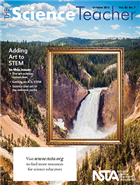 the peer-reviewed journal just for high school teachers; to write for the journal, see our Author Guidelines and Call for Papers; connect on the high school level science teaching list (members can sign up on the list server); or consider joining your peers at future NSTA conferences.
the peer-reviewed journal just for high school teachers; to write for the journal, see our Author Guidelines and Call for Papers; connect on the high school level science teaching list (members can sign up on the list server); or consider joining your peers at future NSTA conferences.
The mission of NSTA is to promote excellence and innovation in science teaching and learning for all. Learn more about the Next Generation Science Standards at the NGSS@NSTA Hub.
Future NSTA Conferences
2016 Area Conferences





